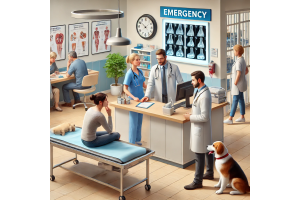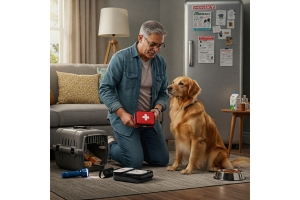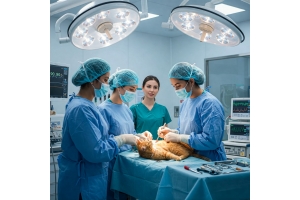Back to Top
How to Change the Environment for a Pet That is Blind

There are many reasons why a pet may become blind in one or both eyes during their lifetime. Blindness in a dog or cat can seem devastating to us, but it is important to remember that a huge proportion of information that dogs and cats process is through smells and sounds. Therefore, they may do as well as we do, or better, without complete vision.
Getting Started
First, consider what is familiar with your home setting for a pet: where a pet sleeps, eats, where the toys are kept, and so on. Try to keep these in the same place or make them more accessible.
Second, consider what may be risky for a pet that can no longer see: staircases, swinging doors, slippery floors, furniture that gets moved, and the like. Try to protect a pet from these, and avoid sudden changes in furniture arrangement.
The cornerstones of management are eliminating risks at the outset and then trying to maintain consistency thereafter so your pet becomes accustomed to the environment without having to see it.
Troubleshooting Beforehand
Slow-onset blindness allows for a period of adaptation, whereas sudden blindness does not. If blindness was slow in developing, a pet may be very comfortable moving around the home and performing most normal activities. If a pet is dealing with sudden blindness, be patient. They often need to be reintroduced to their normal surroundings to adjust to this big change. Sometimes healing has to take place before the pet is comfortable enough to return to normal behaviors and habits.
While trying to preserve a normal and enjoyable lifestyle for a blind pet, it is important to realize that is it neither advisable nor safe for a blind dog or cat to be outside and roaming freely in an unprotected area.
Procedure for Adapting the Home to a Blind Pet
The following ways of modifying a pet’s environment or lifestyle can help him/her adjust more quickly to blindness:
- Furniture—If furniture in the home has to be relocated, do it gradually. For example, try moving a large chair or couch by a few feet per day until it reaches its final destination. This way your pet can adjust his or her walking path without colliding into a new obstacle or learn not to try to jump on something that is no longer there. Pets that are accustomed (and allowed) to jumping on a piece of furniture may initially require assistance to do so. They can be trained to use an intermediate step, for example, to reach a taller couch.
- Stairs—Use baby or dog gates to block entrance to stairs. Falling down stairs can be a significant danger to blind pets. If steps cannot be avoided—when going in and out of the house for example—try using a harness and leash to provide extra support and guidance.
- Food/water bowls—Try to keep food and water bowls in the same place a pet would expect them to be. One example that may require changing locations includes moving a cat’s bowl from an elevated place to the floor to avoid forcing the cat to jump up to reach the bowl. A change like this may mean monitoring during mealtime to keep other pets from eating a cat’s food.
- Toys—If toys are kept in a container and a pet is used to getting these toys out, something more easily accessible may be needed. For example, if toys were stored in a tall tub, then a low-lipped basket should take its place.
- Outside exercise—If a pet is used to daily walks outside, this should continue. However, it is extremely important to be watchful at all times because we quickly slip back into the habit of assuming a pet can see danger, especially soon after the onset of blindness. Walking outside is part of a healthy lifestyle, but it is essential to remember that a pet who would previously have seen a car coming now will not and can walk right into the middle of a busy street. Safe outdoor activity includes using a leash for guiding a completely blind pet and providing them protection from other animals, vehicles, and obstacles.
- In/out of vehicles—A pet may adjust quickly to gauging short distances when jumping. Initially, however, the pet should be lifted in and out of vehicles. This may progress to assisted jumping and finally to jumping in and out unassisted. Every pet is different, and not all animals will be willing or able to perform athletic activities at their former level.
- Scents—Placing a specific perfume or scent in a single key location can be an important and useful marker. For example, placing an air freshener or room deodorizer near a flight of steps becomes a reference point for a blind dog or cat, helping him/her to know to be cautious when in that area. Be careful not to overwhelm the environment with too many scents or use the same scent in more than one location.
Afterwards
In the vast majority of cases, pets adapt exceptionally well to life without vision. They have other senses that are very strong, and you might be surprised how quickly they adjust. One example includes a cat that regained the ability to hunt and catch birds in the yard despite complete blindness in both eyes. If quality of life for a pet is a concern because of blindness, please contact your veterinarian and discuss these worries, fears, and any issues related to adjusting to this new lifestyle.






